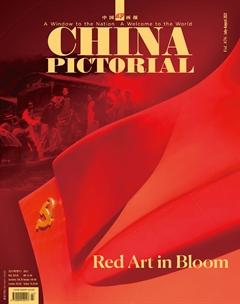A Hundred Years of History on Canvas
by Fan Dian
In the 1920s, many Chinese artists began to use art to reflect social reality. Works of the era shone light in dark corners of society and encouraged people to pursue democracy and freedom. After the outbreak of the Chinese Peoples War of Resistance against Japanese Aggression, the fight led by the Communist Party of China (CPC) against the invaders won great support from the Chinese people, and a wave of artists headed to Yanan in northwestern Chinas Shaanxi Province, a revolutionary base of the CPC at the time, leading to a peak in revolutionary art.
The 1935 work Roar, China! by Li Hua, like many other woodblock prints of that time, reflects the fighting resolution of Chinese soldiers and civilians to resist foreign aggression and support the new trend led by Yanan and other resistance bases.
After the founding of the Peoples Republic of China in 1949, creation within specific themes became a new trend of Chinese art. From the 1950s through the 1970s, China organized four large-scale art creation drives on revolutionary history themes which inspired countless excellent art classics including The Founding Ceremony of the Peoples Republic of China by Dong Xiwen in 1953 and Liberation of Beiping (Beijing) by Ye Qianyu in 1959. Those works have made up the lack of historical photos on such milestone events and depicted the revolutionary history in the first half of the 20th century with vivid paintings.
To create such works, artists dove into historical scenes to make them look more realistic. By reproducing history with artworks, they created a visual narration of history. Some important historical events were given more attention. For example, series about the Long March like Taking the Luding Bridge by Force by Li Zongjin in 1951 and The Red Army Crosses the Snowy Mountain by Ai Zhongxin in 1957 highlighted the great courage and spirit of Chinese soldiers during the Long March.
Since the beginning of Chinas reform and opening up in the late 1970s, works with themes expressing the collective memories of the country and the nation have been popular. Through the diversified expansion of creative techniques, forms, styles, and content, a new trend of art in an era full of pioneering spirit and innovative consciousness emerged.
For example, Stele Forest, an ink-and-wash painting by Tian Liming to commemorate the 40th anniversary of the victory of the Chinese Peoples War of Resistance against Japanese Aggression, eulogizes revolutionary martyrs who sacrificed their lives in the war of resistance. Taihang Iron Wall created by Wang Yingchun and Yang Lizhou in 1984 depicts the historical scene of Zhu De, Peng Dehuai, Deng Xiaoping, and other veteran revolutionaries working hand in hand with soldiers and civilians in the Taihang Mountains to fight Japanese invaders. Chinese ink paintings from the era employed delicate drawing skills to depict revolutionary martyrs with abundant passion. Artists used symbolic techniques to paint historical revolutionary figures and events in a way that highlighted the spirit of revolutionary themes through innovative forms of artistic language.
The artistic creation of this period shared a common phenomenon: Development of the times caused artists understanding and expression of revolutionary history and realistic themes to undergo profound changes, especially among the younger generation of artists who began deploying artistic language with personal style to achieve breakthroughs and transcendence in creation and expression of major themes.
Over the past decade, China has launched numerous themed art creation projects to catapult the central themes of new art creation into a brand new development stage by making the themes of art creation more scientific and rigorous in organization.
Realizing integration of ideological values and artistic values within art themes, pursuing new artistic realms while preserving realistic art creation traditions, and creating profound tributes to the times have become important missions shouldered by contemporary artists, which inspire artists to respond to the times.
Looking back at the past century, Chinese art has mirrored the development of the times and resonated with the emotions of the people. Today, peoples appreciation and demands for excellent art are increasing, prompting artists to learn more about history to capture the rhythm of the times, understand changes in history, and reach out to the love for the motherland. Chinese artists today seek to produce works that touch hearts, resonate broadly, and reverberate eternally across the next 100 years.

